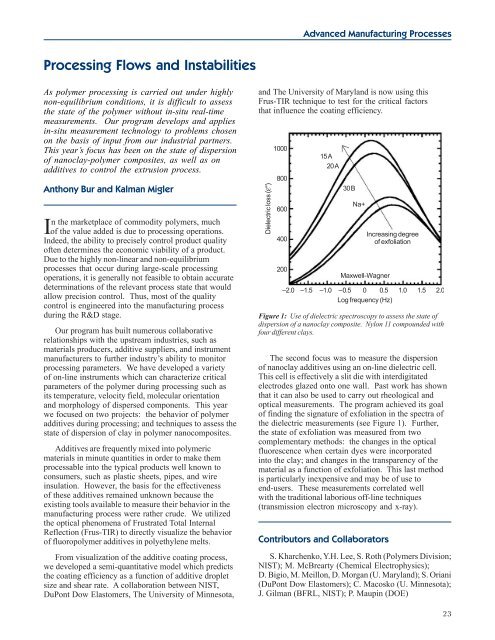Materials Science and Engineering Laboratory FY 2004 ... - NIST
Materials Science and Engineering Laboratory FY 2004 ... - NIST
Materials Science and Engineering Laboratory FY 2004 ... - NIST
You also want an ePaper? Increase the reach of your titles
YUMPU automatically turns print PDFs into web optimized ePapers that Google loves.
Processing Flows <strong>and</strong> Instabilities<br />
As polymer processing is carried out under highly<br />
non-equilibrium conditions, it is difficult to assess<br />
the state of the polymer without in-situ real-time<br />
measurements. Our program develops <strong>and</strong> applies<br />
in-situ measurement technology to problems chosen<br />
on the basis of input from our industrial partners.<br />
This year’s focus has been on the state of dispersion<br />
of nanoclay-polymer composites, as well as on<br />
additives to control the extrusion process.<br />
Anthony Bur <strong>and</strong> Kalman Migler<br />
In the marketplace of commodity polymers, much<br />
of the value added is due to processing operations.<br />
Indeed, the ability to precisely control product quality<br />
often determines the economic viability of a product.<br />
Due to the highly non-linear <strong>and</strong> non-equilibrium<br />
processes that occur during large-scale processing<br />
operations, it is generally not feasible to obtain accurate<br />
determinations of the relevant process state that would<br />
allow precision control. Thus, most of the quality<br />
control is engineered into the manufacturing process<br />
during the R&D stage.<br />
Our program has built numerous collaborative<br />
relationships with the upstream industries, such as<br />
materials producers, additive suppliers, <strong>and</strong> instrument<br />
manufacturers to further industry’s ability to monitor<br />
processing parameters. We have developed a variety<br />
of on-line instruments which can characterize critical<br />
parameters of the polymer during processing such as<br />
its temperature, velocity field, molecular orientation<br />
<strong>and</strong> morphology of dispersed components. This year<br />
we focused on two projects: the behavior of polymer<br />
additives during processing; <strong>and</strong> techniques to assess the<br />
state of dispersion of clay in polymer nanocomposites.<br />
Additives are frequently mixed into polymeric<br />
materials in minute quantities in order to make them<br />
processable into the typical products well known to<br />
consumers, such as plastic sheets, pipes, <strong>and</strong> wire<br />
insulation. However, the basis for the effectiveness<br />
of these additives remained unknown because the<br />
existing tools available to measure their behavior in the<br />
manufacturing process were rather crude. We utilized<br />
the optical phenomena of Frustrated Total Internal<br />
Reflection (Frus-TIR) to directly visualize the behavior<br />
of fluoropolymer additives in polyethylene melts.<br />
From visualization of the additive coating process,<br />
we developed a semi-quantitative model which predicts<br />
the coating efficiency as a function of additive droplet<br />
size <strong>and</strong> shear rate. A collaboration between <strong>NIST</strong>,<br />
DuPont Dow Elastomers, The University of Minnesota,<br />
Advanced Manufacturing Processes<br />
<strong>and</strong> The University of Maryl<strong>and</strong> is now using this<br />
Frus-TIR technique to test for the critical factors<br />
that influence the coating efficiency.<br />
Figure 1: Use of dielectric spectroscopy to assess the state of<br />
dispersion of a nanoclay composite. Nylon 11 compounded with<br />
four different clays.<br />
The second focus was to measure the dispersion<br />
of nanoclay additives using an on-line dielectric cell.<br />
This cell is effectively a slit die with interdigitated<br />
electrodes glazed onto one wall. Past work has shown<br />
that it can also be used to carry out rheological <strong>and</strong><br />
optical measurements. The program achieved its goal<br />
of finding the signature of exfoliation in the spectra of<br />
the dielectric measurements (see Figure 1). Further,<br />
the state of exfoliation was measured from two<br />
complementary methods: the changes in the optical<br />
fluorescence when certain dyes were incorporated<br />
into the clay; <strong>and</strong> changes in the transparency of the<br />
material as a function of exfoliation. This last method<br />
is particularly inexpensive <strong>and</strong> may be of use to<br />
end-users. These measurements correlated well<br />
with the traditional laborious off-line techniques<br />
(transmission electron microscopy <strong>and</strong> x-ray).<br />
Contributors <strong>and</strong> Collaborators<br />
S. Kharchenko, Y.H. Lee, S. Roth (Polymers Division;<br />
<strong>NIST</strong>); M. McBrearty (Chemical Electrophysics);<br />
D. Bigio, M. Meillon, D. Morgan (U. Maryl<strong>and</strong>); S. Oriani<br />
(DuPont Dow Elastomers); C. Macosko (U. Minnesota);<br />
J. Gilman (BFRL, <strong>NIST</strong>); P. Maupin (DOE)<br />
23

















